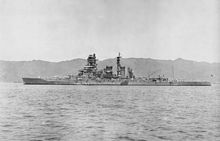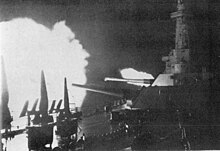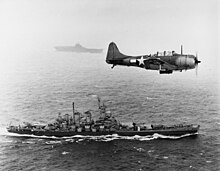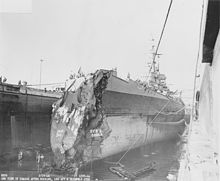USS Washington (BB-56)
USS Washington (BB-56) was the second and final member of the North Carolina class of fast battleships, the first vessel of the type built for the United States Navy.
Washington then moved to the east coast of the US, where she was refitted to serve as a troop transport as part of Operation Magic Carpet, carrying a group of over 1,600 soldiers home from Britain.
Her original light battery of eighteen .50-cal machine guns was decreased to twelve and twenty 20 mm (0.79 in) Oerlikon autocannon in single mounts were installed in early 1942.
[2] She began builder's sea trials on 3 August, but like her sister ship North Carolina, she suffered from excessive vibration while running at high speed from her original three-bladed screws.
Tests continued during her shakedown cruise and subsequent initial training, which were conducted along the East Coast of the United States, as far south as the Gulf of Mexico.
The ships, based out of Nouméa and Espiritu Santo in the New Hebrides, covered convoys bringing supplies and reinforcements to the marines fighting on Guadalcanal into early November.
[7] During one of these convoy operations in mid-October, Washington, a pair of cruisers, and five destroyers provided distant support but were too far away to take part in the Battle of Cape Esperance on the night of 11–12 October.
On 13 November, after learning that a major Japanese attack was approaching, Halsey detached South Dakota, Washington, and four of the destroyers as Task Group 16.3, again under Lee's command.
Enterprise, her forward elevator damaged from the action at Santa Cruz, was kept to the south as a reserve and to prevent the sole operational American carrier in the Pacific from being lost.
[16] As Lee's task group approached Guadalcanal, his Japanese counterpart, Admiral Nobutake Kondō steamed to meet him with his main bombardment force, consisting of the fast battleship Kirishima, the heavy cruisers Takao and Atago, and a destroyer screen.
That evening, American reconnaissance aircraft spotted Japanese warships off Savo Island, prompting Lee to order his ships to general quarters.
[19][20] Shortly thereafter, at about 23:30, an error in the electrical switchboard room knocked out power aboard South Dakota, disabling her radar systems and leaving the ship all but blind to the Japanese vessels approaching the force.
Kirishima was badly holed below the waterline, her forward two turrets were knocked out, and her rudder was jammed, forcing her to steer in a circle to port with an increasing starboard list.
[23] Washington then shifted fire to Atago and Takao, and though straddled the former, failed to score any significant hits; the barrage nevertheless convinced both cruisers to turn off their search lights and reverse course in an attempt to launch torpedoes.
For the voyage, she was attached to TG 56.14, and on arriving in the area was detached on 5 August to proceed independently to Havannah Harbor at Efate in the New Hebrides, which she reached two days later.
Washington spent the next two months conducting tactical training with the carrier task forces in the Efate area in preparation for upcoming campaigns in the central Pacific.
On 6 December, with the fighting in the Gilberts over, Washington was detached to create TG 50.8 along with North Carolina, South Dakota, Alabama, Indiana, and Massachusetts, covered by Bunker Hill, Monterey, and eleven destroyers.
Having arrived off the main target at Kwajalein by late January, Washington screened the carriers while they conducted extensive strikes on the island and neighboring Taroa.
[7] While patrolling off the island in the early hours of 1 February, Indiana cut in front of Washington to go refuel a group of destroyers, causing the latter to ram the former and significantly damaging both ships.
[7] Shortly after Washington arrived, the fleet got underway to begin the assault on the Mariana Islands; the carriers struck targets on Saipan, Tinian, Guam, Rota, and Pagan to weaken Japanese defenses before ground forces went ashore.
Washington and the other battleships, with four cruisers and thirteen destroyers, were deployed some 15 nautical miles (28 km; 17 mi) west of the carrier groups to screen the likely path of approach.
The attacks lasted until 6 August, when Washington, Indiana, Alabama, the light cruiser Birmingham, and escorting destroyers were detached as TG 58.7 to proceed to Eniwetok.
There, the carriers began a series of strikes from 6 to 8 September on various targets in the Palaus; Washington contributed her heavy guns to the bombardment of Peleliu and Anguar before the marines assaulted both islands later that month.
[7] TF 38 embarked on the raids to isolate the Philippines and suppress the units of the 1st Air Fleet on 6 October; Washington remained Lee's flagship, attached to TG 38.3.
[40] Halsey detached the battleships Iowa and New Jersey as TG 34.5 to pursue Kurita through the San Bernardino Strait while Lee took the rest of his ships further southwest to try to cut off his escape, but both groups arrived too late.
[42] The units of TF 38 got underway again on 11 December for more attacks on Luzon to suppress Japanese aircraft as the amphibious force prepared for its next landing on the island of Mindoro in the western Philippines.
The damage inflicted on the fleet delayed further support of ground troops for two days and the continuing bad weather led Halsey to break off operations; the ships arrived back in Ulithi on 24 December.
The next day, the carrier groups entered the South China Sea, where it refueled and then struck targets in French Indochina on the assumption that significant Japanese naval forces were present, but only merchant ships and a number of minor warships were caught and sunk there.
[7][47] After completing her refit in September, Washington conducted sea trials, followed by a short period of training while based in San Pedro, Los Angeles.
Beginning already in 1946, the Ships Characteristics Board authorized the removal a number of the 40 mm guns from the North Carolina and South Dakota class battleships that had been decommissioned.














